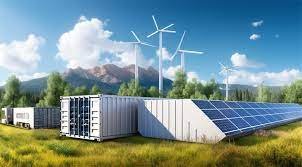Solar power has emerged as a transformative renewable energy source, offering a clean and sustainable solution to the global energy crisis. However, its widespread adoption faces a fundamental challenge: intermittency. Solar energy generation depends on sunlight, which is unavailable at night and can be reduced during cloudy weather. This limitation can disrupt energy supply and grid stability. Advanced energy storage systems play a pivotal role in addressing these challenges by ensuring a consistent and reliable energy flow, maximizing the utility of solar power plants.

The Role of Energy Storage Systems
Energy storage systems (ESS) bridge the gap between energy generation and consumption. By storing excess energy produced during peak sunlight hours, ESS ensures energy availability during periods of low or no solar output. This not only stabilizes the grid but also optimizes the economic value of solar installations.
Key energy storage technologies that support solar power include:
- Battery Storage Systems
Lithium-ion and sodium-sulfur batteries are leading the charge in solar energy storage. These batteries offer high efficiency, scalability, and rapid deployment capabilities, making them ideal for residential and utility-scale solar projects. - Thermal Energy Storage
Solar thermal systems store heat in materials like molten salt, which can be converted back into electricity when needed. This is particularly effective for concentrated solar power (CSP) plants. - Pumped Hydro Storage
Excess solar energy powers pumps that elevate water to a reservoir. When energy is required, the stored water flows downhill through turbines to generate electricity. This method is widely used for large-scale energy storage. - Flywheel Energy Storage
Flywheels store rotational energy, offering short-term energy supply and grid stabilization. They are gaining attention for their durability and low maintenance.
Benefits of Combining Solar Power with ESS
Integrating energy storage systems with solar power plants offers several advantages:
- Reliable Power Supply
ESS ensures power availability during night hours and adverse weather conditions, effectively mitigating the intermittency problem. - Grid Stability and Frequency Regulation
ESS supports grid operations by providing rapid responses to fluctuations, thus enhancing stability and frequency regulation. - Enhanced Energy Independence
Solar power with ESS reduces reliance on fossil fuels and external energy imports, promoting energy security. - Economic Efficiency
Storing energy during low-demand periods and utilizing it during peak demand helps in reducing energy costs for consumers and increases revenue for plant operators. - Facilitating Microgrids
ESS enables the creation of microgrids—localized energy networks that function independently from the main grid. This is especially valuable for remote and underserved areas.
Challenges and Future Prospects
Despite their benefits, energy storage systems face challenges such as high initial costs, limited lifespan, and environmental concerns related to battery disposal. However, continuous advancements in technology, economies of scale, and supportive government policies are driving down costs and improving efficiency. Innovations like solid-state batteries, hydrogen storage, and AI-driven energy management are set to revolutionize the sector further.
Conclusion
The combination of solar power and advanced energy storage systems is a game-changer for the renewable energy landscape. By addressing the intermittency issue, these systems unlock the full potential of solar energy, paving the way for a cleaner, more sustainable energy future. Governments, industries, and communities must continue to invest in and adopt these technologies to ensure a resilient and reliable energy supply for generations to come.






